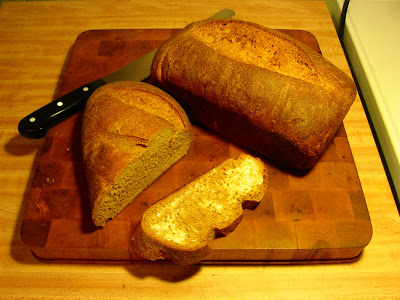This is a very slightly modified version of the Oatmeal Molasses Bread in the Joy of Cooking (the updated one from the late 90s). I just wanted it a little softer so I subbed in some milk and an egg where the original uses only water.
total prep/rise/bake time: 4 1/2 to 5 hours (mostly hands off rising time)
makes 2 loaves (or a lot of rolls, if you want)
Combine and allow to come to room temperature:
1/2 c milk
1/3 c molasses
1 egg
In a medium saucepan, combine:
1 1/4 c oatmeal
1 3/4 c water
1 tbsp butter
3/4 tsp salt
bring to a boil, and cook on low for about 20 minutes until it's super thick and dense. Get it out of the pan, and onto a plate to cool to about 115 degrees (if you don't have an instant read thermometer, 115 feels just pleasantly warm, not hot). Incidentally, if you ever have about 2 cups of leftover cooked oatmeal (it might happen...), you could just use that, adding the melted butter and salt separately.
In the bowl of a stand mixer, combine:
2 tbsp room temperature sourdough starter (optional)
1/4 c warm (115 degree) water
2 tsp yeast (if you don't use any starter, use 2 1/2 tsp yeast total)
let it stand for 5-10 minutes, till it's bubbly. When the oatmeal is cool enough to touch (115 degrees), add it, along with the milk/molasses/egg mixture to the yeast/starter mixture and combine thoroughly. Add:
2 c bread flour
2 c whole wheat flour
Using the dough hook, mix on low until thoroughly combined (or stir with a spoon by hand until it mostly comes together and then turn it out onto a board to continue kneading). Continue to add up to 1 extra cup of flour, until you have a dough that's moist but not sticky. If you're using a mixer, let it knead the dough for 10-15 minutes. I would recommend pulling it out to knead in a bit more flour on your countertop to make sure the dough is cohesive.
Plop the dough into an oiled bowl, turning it to coat it all over with oil, cover the bowl with plastic wrap and put it somewhere warm to rise, 1 to 1 1/2 hours, until doubled (I put it on my radiator). Punch down the dough (or just sort of knead the air out of it, really) and divide the dough into two pieces (at this point I cut out an extra 30 minutes of "resting" time and saw no ill effects... if you have a lot of time on your hands you can add that in here).
Now you have a couple of options for forming the loaves. The original recipe is for two 8 1/2 by 4 1/2 bread pans, which you could do; but I only have one 9 by 5 bread pan - so instead of dividing the dough in equal halves, I separated it 2/3 (for the 9 by 5 pan) and 1/3 (for a free form loaf I baked on a sheet pan) (by the way I totally recommend getting a scale so you can weigh out your dough, mine was only about $15 and I use it all the time for baking and it's great); however you divide it, if you use loaf pans, grease them up really throughly, and if you want to make free form loaves, bake them on parchment lined (or cornmeal sprinkled) sheet pans.
Shape the loaves (I did a batard for my free form one, which is like a big fat baguette); put them in/on the pans, cover with plastic wrap and let rise in a warm place (on top of your preheating oven, for example) again until doubled, 1 to 1 1/2 hours.
During the rising time, preheat your oven to 375. Bake the loaves for about 40 minutes, or until they're deep golden brown, and they sound hollow when you tap them on the bottom.
Cool on a rack for about 30 minutes before cutting into it, if you can stand to wait that long. Actually we couldn't stand to wait that long, and it was fine. In fact, it was awesome, because the butter totally melted right onto that delicious hot bread and it was soooo goooooooooood.


No comments:
Post a Comment